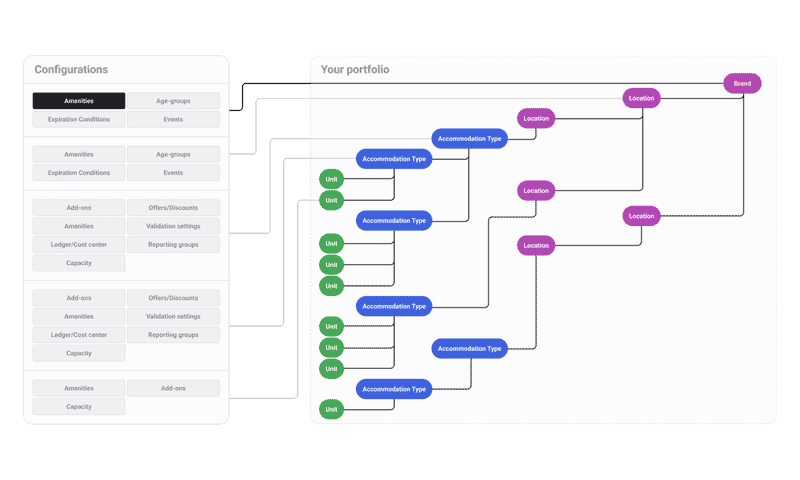The hidden architecture behind scalable operations
How Maxxton helps operators manage complexity without the chaos

Running operations across resorts, campsites or holiday parks isn’t straightforward. You’re working with multiple brands, countries, locations, accommodation types, and hundreds, sometimes thousands, of individual units.
To manage that well, you need two things:
First, efficiency. You want the ability to set rules like booking conditions or pricing once and apply them across your entire operation.
Second, precision. You also need the flexibility to make changes for specific sites, types, or even individual units, when it matters.
Most systems force you to choose between those two things. Maxxton doesn’t.
One structure, two goals
Maxxton’s configuration system is built on hierarchy. That means you can define rules at different levels of your setup, like brand or country all the way down to a single accommodation unit.
Almost anything you set at a higher level is inherited automatically by everything beneath it. But if you need to make an exception, for a park, a type, or one specific unit, you can override the rule without unravelling the rest of your setup.
Let’s say you want to apply a €20 booking fee across all your parks in France, you set it once at the country level. Done. If VAT changes in the Netherlands from 9% to 21%, you update that single rule, and the system adjusts rates across all affected properties, types, and units, instantly and accurately.
This kind of cascading logic allows you to build a strong, scalable foundation, but still respond to local differences and exceptions.
Managing complexity through hierarchy
A typical setup might begin with company-wide policies like standard reservation conditions, loyalty programme logic, and reporting structures. These sit at the brand level and apply across your operation.
At the country or region level, you layer in rules for things like VAT and tourist taxes, school holidays, or legal booking restrictions, all of which vary by territory.
Drill down further, and the location or park level lets you configure local add-ons (like bike rental), site-specific discounts, or group policies for accommodation clusters. At the accommodation type level, you define base pricing, occupancy limits, and the availability of add-ons for each category, say, bungalows vs. mobile homes.
Finally, the unit level gives you control over exceptions, think of two specific units with hot tubs. Instead of creating a whole new type, just tag them, apply a paid preference, and let guests book them directly.
Using age groups for pricing, tax, and logic
One example of hierarchical configuration in action is how Maxxton handles age groups. These can be defined at the brand or country level and then reused consistently across pricing, tax logic, and booking conditions.
For instance, a country may exempt children under 12 from tourist tax. Or a resort may offer free stays for infants. Age groups, such as babies (0–2), children (3–11), adults (12–64), and seniors (65+), are defined once and applied throughout the system.
This helps keep consistency in billing and compliance with local legislation, without requiring manual checks or repeated configuration across parks.
Reuse is the real efficiency
Hierarchy isn’t just about scale, it’s also about not having to repeat yourself. Maxxton lets you start broad, then refine. You can reuse existing structures when onboarding a new park or launching a new season, and only tweak what’s different. That means faster setup, less manual work, and fewer errors.
The same logic powers Maxxton’s dynamic pricing: set strategy by location, type, or group, and let the system automatically adapt pricing in real time based on demand and occupancy. No need for manual adjustments every time something changes.
Push that logic to every channel
Maxxton’s Channel Manager also runs on this same logic. Pricing, availability and booking rules can be pushed from your core configuration to third-party platforms like Booking.com or Expedia, with variations for each channel where needed, like recalculated commission or adjusted lead times. That means you won’t have to deal with double entries or version conflicts. You’ll have clean, structured data, end to end.
A consistent foundation across everything
Rules aren’t just rules. They’re what keep your operation consistent and scalable. It doesn’t matter if it’s tourist tax exemptions for children under 12, optional booking holds with 24-hour expiry, or site-specific discounts for preferred units, when the logic is in one place, your team can trust what’s in the system.
You save time, reduce risk and keep control, even as you scale.
Final thoughts
Running a resort isn’t like running a hotel. There’s more to manage, more locations, more unit types, more variations and edge cases. That complexity isn’t a flaw, it’s just how the business works.
Maxxton was built with that in mind. The way we handle configuration, through hierarchy and granularity, wasn’t just a theory. It came from what operators told us they were already doing, just with more effort and less support from their systems.
So we built it in. You can define structure at scale, but still make changes when the details demand it. Logic that applies across brands and adjustments for one unit. You get flex where it matters and consistency where it counts.
Maxxton is designed to bring those tensions together: freedom and rules, complexity and scale, control and ease of use.
You don’t have to choose one or the other. You just need the right system behind you.

